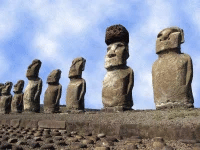The Mystery of Easter Island: Unveiling the Secrets of a Remote Enigma

Easter Island, or Rapa Nui, is a remote and isolated speck of land in the vast expanse of the Pacific Ocean. Known for its iconic stone statues, the moai, and its rich cultural heritage, this enigmatic island captivates the imagination and invites us to delve into its profound mysteries. The story of Easter Island is a tale of ingenuity, isolation, and the search for meaning that transcends time and space.
The Moai Statues: Guardians of an Ancient Legacy
The moai statues, which dominate the landscape of Easter Island, are among the most recognizable and enigmatic artifacts of the ancient world. These colossal stone figures, ranging in height from 6 to 33 feet and weighing up to 75 tons, were crafted with remarkable skill and precision, representing the spiritual and cultural essence of the Rapa Nui people.
-
Origins and Construction: The construction of the moai is a testament to the artistry and engineering prowess of the Rapa Nui. Carved primarily from volcanic tuff, the statues were sculpted using primitive tools and techniques. The process of quarrying, transporting, and erecting these massive statues required significant labor and coordination, reflecting a highly organized society with a deep sense of purpose and devotion.
-
Symbolism and Purpose: The moai were created to honor ancestral leaders and chiefs, serving as a representation of their mana, or spiritual power. Placed on stone platforms known as ahu, these statues were positioned to face inland, symbolizing their protective role over the communities. The placement and orientation of the moai reflect a profound connection with the spiritual and social structure of the Rapa Nui society.
-
Cultural and Spiritual Significance: The moai embody the cultural and spiritual beliefs of the Rapa Nui people, representing a sacred link between the living and the ancestors. The statues are integral to the island's ceremonial practices and social organization, reflecting the importance of ancestral reverence and spiritual connection.
The Enigma of the Island’s Collapse
The history of Easter Island is not only marked by its monumental achievements but also by its dramatic rise and fall. The collapse of the Rapa Nui society is a poignant reminder of the fragility of human endeavors and the complex interplay between environment, culture, and survival.
-
Environmental Impact: The construction of the moai and the accompanying societal demands led to significant environmental changes on the island. Deforestation, soil erosion, and resource depletion impacted the island’s ecological balance, contributing to the decline of the Rapa Nui civilization. The environmental consequences of these activities highlight the delicate relationship between human actions and the natural world.
-
Social and Political Factors: Internal conflicts, including civil wars and competition for resources, further exacerbated the challenges faced by the Rapa Nui. The societal upheaval and the eventual decline of the moai construction reflect the broader struggles of the island’s inhabitants in the face of environmental and social pressures.
-
Rediscovery and Preservation: In the 19th and 20th centuries, Easter Island faced significant challenges related to colonialism, disease, and external influences. Efforts to preserve and protect the island’s heritage have been ongoing, with a focus on restoring the moai and supporting the Rapa Nui community in their cultural and environmental stewardship.
The Legacy of Easter Island: A Call to Reflection
The mystery of Easter Island invites us to reflect on the timeless themes of human ingenuity, environmental stewardship, and the quest for meaning. The island's legacy serves as a powerful reminder of our interconnectedness with the world and the enduring pursuit of knowledge and understanding.
-
Embracing Human Ingenuity: The creation of the moai statues represents the remarkable ingenuity and creativity of the Rapa Nui people. It challenges us to honor and celebrate the achievements of past civilizations and to draw inspiration from their resilience and vision.
-
Reflecting on Environmental Stewardship: The environmental impact of the moai construction offers a profound lesson on the importance of sustainable practices and the need to balance human activities with ecological preservation. It calls us to consider our own relationship with the environment and to take responsibility for the health of our planet.
-
Honoring Cultural Legacy: The story of Easter Island underscores the significance of cultural heritage and the need to preserve and respect the traditions and values of indigenous communities. It encourages us to engage with and learn from the rich cultural legacies that shape our world.
Celebrating the Mysteries with Omnithreads
At Omnithreads, we celebrate the profound mysteries of Easter Island through our spiritually infused designs. Each piece of clothing is crafted to resonate with the ancient wisdom and cultural significance of this remarkable island.
Join us in honoring the legacy of Easter Island. Let our designs inspire you to connect with the deeper dimensions of existence, explore the mysteries of human ingenuity, and celebrate the timeless significance of ancient wonders. Through our creations, we invite you to embrace the profound secrets of Easter Island and the eternal quest for understanding.
















Leave a comment